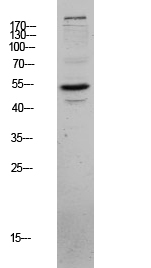产品名称
CLUS Rabbit Polyclonal Antibody
别名
Clusterin (Aging-associated gene 4 protein) (Apolipoprotein J) (Apo-J) (Complement cytolysis inhibitor) (CLI) (Complement-associated protein SP-40,40) (Ku70-binding protein 1) (NA1/NA2) (Testosterone-repressed prostate message 2) (TRPM-2) [Cleaved into: Clusterin beta chain (ApoJalpha) (Complement cytolysis inhibitor a chain); Clusterin alpha chain (ApoJbeta) (Complement cytolysis inhibitor b chain)]
基因名称
CLU APOJ CLI KUB1 AAG4
蛋白名称
Clusterin (Aging-associated gene 4 protein) (Apolipoprotein J) (Apo-J) (Complement cytolysis inhibitor) (CLI) (Complement-associated protein SP-40,40) (Ku70-binding protein 1) (NA1/NA2) (Testosterone-repressed prostate message 2) (TRPM-2) [Cleaved into: Clusterin beta chain (ApoJalpha) (Complement cytolysis inhibitor a chain); Clusterin alpha chain (ApoJbeta) (Complement cytolysis inhibitor b chain)]
存储缓冲液
Liquid in PBS containing 50% glycerol, 0.5% BSA and 0.02% New type preservative N.
Human Gene Link
http://www.ncbi.nlm.nih.gov/sites/entrez?db=gene&term=1191
Human Swissprot No.
P10909
Human Swissprot Link
http://www.uniprot.org/uniprotkb/P10909/entry
Mouse Swissprot No.
Q06890
Mouse Swissprot Link
http://www.uniprot.org/uniprot/Q06890
Rat Swissprot Link
http://www.uniprot.org/uniprot/O54941P05371
免疫原
Synthesized peptide derived from human CLUS Polyclonal
特异性
This antibody detects endogenous levels of CLUS.
稀释度
WB 1:500-2000, ELISA 1:10000-20000
宿主
Polyclonal, Rabbit,IgG
背景介绍
The protein encoded by this gene is a secreted chaperone that can under some stress conditions also be found in the cell cytosol. It has been suggested to be involved in several basic biological events such as cell death, tumor progression, and neurodegenerative disorders. Alternate splicing results in both coding and non-coding variants.[provided by RefSeq, May 2011],
组织表达
Detected in blood plasma, cerebrospinal fluid, milk, seminal plasma and colon mucosa. Detected in the germinal center of colon lymphoid nodules and in colon parasympathetic ganglia of the Auerbach plexus (at protein level). Ubiquitous. Detected in brain, testis, ovary, liver and pancreas, and at lower levels in kidney, heart, spleen and lung.
细胞定位
[Isoform 1]: Secreted . Can retrotranslocate from the secretory compartments to the cytosol upon cellular stress. .; [Isoform 4]: Cytoplasm . Keeps cytoplasmic localization in stressed and unstressed cell. .; [Isoform 6]: Cytoplasm . Keeps cytoplasmic localization in stressed and unstressed cell. .; Nucleus . Cytoplasm . Mitochondrion membrane; Peripheral membrane protein; Cytoplasmic side . Cytoplasm, cytosol . Microsome . Endoplasmic reticulum . Mitochondrion . Mitochondrion membrane . Cytoplasm, perinuclear region . Cytoplasmic vesicle, secretory vesicle, chromaffin granule . Secreted isoforms can retrotranslocate from the secretory compartments to the cytosol upon cellular stress (PubMed:17451556). Detected in perinuclear foci that may be aggresomes containing misfolded, ubiquitinated proteins (PubMed:20068069). Detected at the mitochondrion membrane upon induction of apoptosis (PubMed:17689225). Under ER stress, a immaturely glycosylated pre-secreted form retrotranslocates from the endoplasmic reticulum (ER)-Golgi network to the cytoplasm to localize in the mitochondria through HSPA5 interaction (PubMed:22689054). ER stress reduces secretion (PubMed:22689054). Under the stress, minor amounts of non-secreted forms accumulate in cytoplasm (PubMed:24073260, PubMed:22689054, PubMed:17451556). Non-secreted forms emerge mainly from failed translocation, alternative splicing or non-canonical initiation start codon (PubMed:24073260, PubMed:12551933). .
功能
function:Not yet clear. It is known to be expressed in a variety of tissues and it seems to be able to bind to cells, membranes and hydrophobic proteins. It has been associated with programmed cell death (apoptosis).,similarity:Belongs to the clusterin family.,subunit:Antiparallel disulfide-linked heterodimer. Interacts with APOA1, CLUAP1 AND PON1.,
纯化
The antibody was affinity-purified from rabbit antiserum by affinity-chromatography using epitope-specific immunogen.

